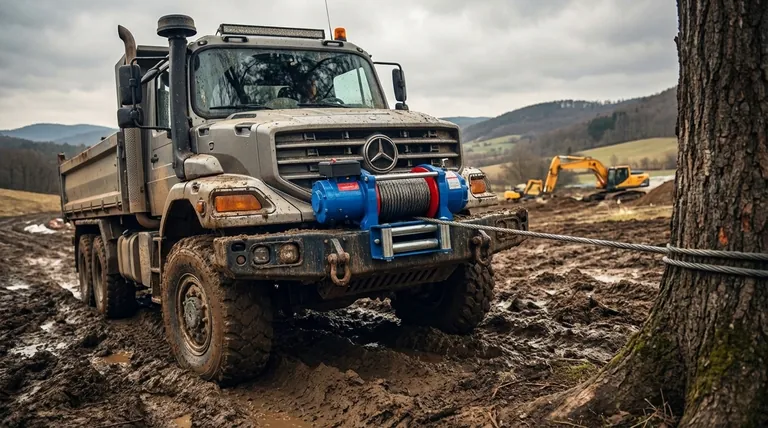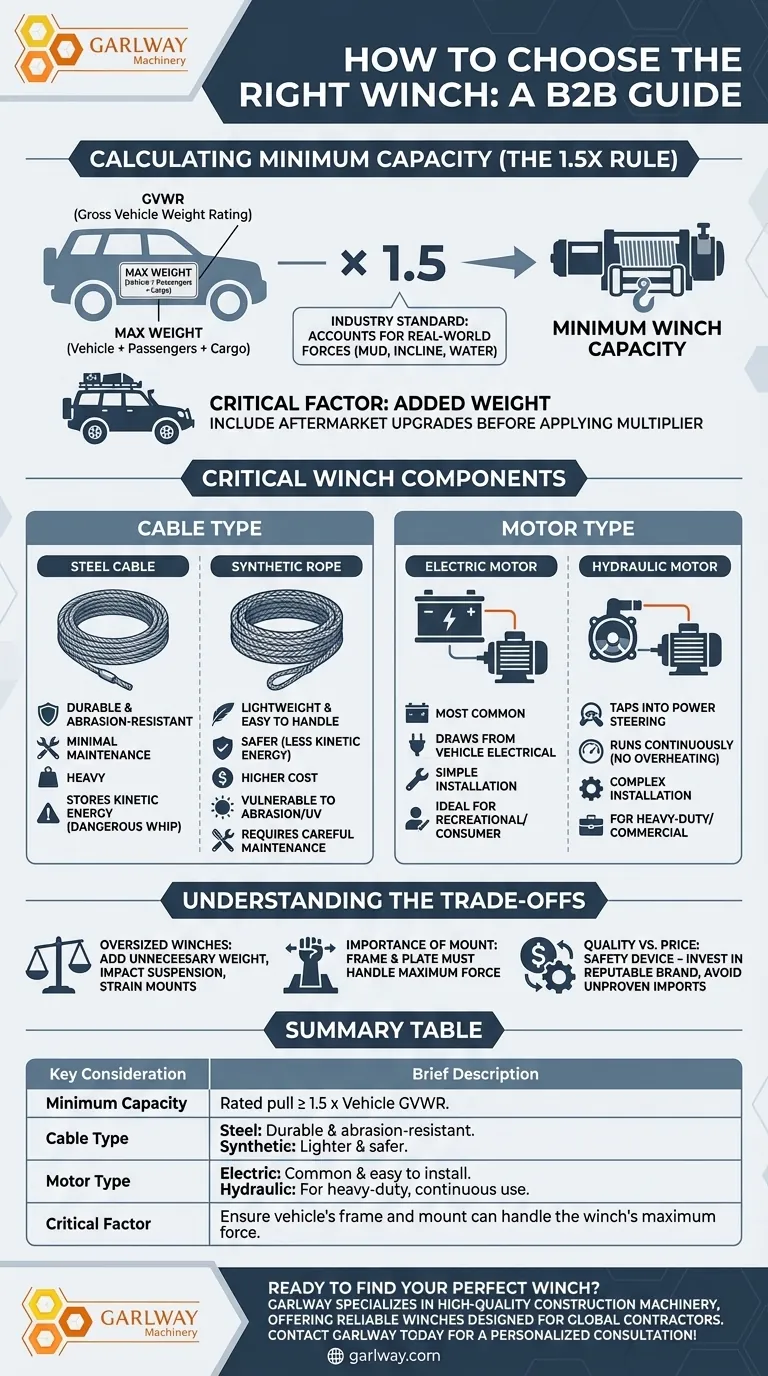To choose the right winch, you must begin with a straightforward calculation. The industry-standard guideline is to select a winch with a rated pulling capacity of at least 1.5 times your vehicle's Gross Vehicle Weight Rating (GVWR). This simple formula establishes the minimum power required for a safe and effective recovery.
Selecting a winch is about more than just hitting a capacity number. The right choice balances calculated power with the correct cable material and motor type for your specific vehicle and intended use, ensuring reliability when you need it most.

Calculating Your Minimum Winch Capacity
Your winch's pulling power, or line pull rating, is its most important specification. A winch that is too weak is a dangerous liability, while one that is excessively powerful is an unnecessary burden on your vehicle.
Start with Gross Vehicle Weight Rating (GVWR)
First, determine the GVWR of your vehicle. This is the maximum operating weight as specified by the manufacturer, including the vehicle itself, passengers, and cargo. You can typically find this information on a sticker inside the driver's side door jamb.
Apply the 1.5x Multiplier
Multiply your vehicle's GVWR by 1.5. For example, if your truck has a GVWR of 6,000 lbs, you should look for a winch with a minimum capacity of 9,000 lbs (6,000 x 1.5 = 9,000).
This multiplier isn't arbitrary. It accounts for the additional forces at play during a real-world recovery, such as the resistance from mud, water, or the friction of pulling up a steep incline.
Account for Additional Weight
The 1.5x rule is the baseline for a stock vehicle. If you have added significant weight with aftermarket upgrades like steel bumpers, roof racks, or larger tires, you must account for that additional weight before applying the multiplier.
Beyond Capacity: Critical Winch Components
Once you have determined your minimum capacity, you must consider the winch's core components. These choices directly impact safety, usability, and durability.
Cable Type: Steel vs. Synthetic Rope
You have two primary options for your winch line, each with distinct characteristics.
Steel cable is highly durable, abrasion-resistant, and requires minimal maintenance. However, it is heavy and can store dangerous kinetic energy, whipping violently if it snaps under load.
Synthetic rope is significantly lighter, easier to handle, and safer because it does not store the same amount of kinetic energy. Its primary drawbacks are a higher cost and a vulnerability to abrasion and UV damage, requiring more careful maintenance.
Motor Type: Electric vs. Hydraulic
The motor is the heart of your winch. The choice depends on your vehicle's capabilities and your expected use case.
Electric winches are the most common type. They draw power from your vehicle's electrical system and are relatively simple to install, making them ideal for the vast majority of consumer and recreational applications.
Hydraulic winches tap into a vehicle's power steering pump for power. They can run continuously without overheating but require a more complex and expensive installation, limiting them to heavy-duty commercial or specialized off-road vehicles.
Understanding the Trade-offs
Choosing the right winch means being aware of the potential pitfalls and making an informed decision based on facts, not just marketing.
The Myth of "Bigger is Always Better"
An oversized winch adds significant, unnecessary weight to the front of your vehicle, negatively impacting suspension and handling. It also places a greater strain on your vehicle's mounting points and electrical system. Stick to the calculated capacity for a balanced and effective setup.
The Importance of the Mount
A powerful winch is useless if the structure it's mounted to fails. Ensure your vehicle's frame and the winch mounting plate are strong enough to handle the forces generated by the winch at its maximum capacity.
Quality vs. Price
A winch is a critical safety device, and this is not the place to cut corners. While you don't necessarily need the most expensive model for occasional use, it is wise to invest in a reputable brand over a low-end, unproven import. A quality winch that works once is infinitely better than a cheap one that fails when you are stranded.
Making the Right Choice for Your Goal
Your final decision should be guided by a clear understanding of your primary objective.
- If your primary focus is occasional recovery for a stock vehicle: A quality electric winch with a 1.5x GVWR capacity and a durable steel cable is a reliable and cost-effective solution.
- If your primary focus is frequent, heavy-duty use or a highly modified vehicle: Invest in a higher capacity winch and a lightweight synthetic rope for its superior safety and handling characteristics.
- If your primary focus is safety and ease of use: A synthetic winch rope is the clear winner, as it dramatically reduces the risk associated with a snapped line.
A well-chosen winch is not just an accessory; it is a critical piece of equipment that provides safety and self-reliance.
Summary Table:
| Key Consideration | Brief Description |
|---|---|
| Minimum Capacity | Rated pull should be at least 1.5 x your vehicle's Gross Vehicle Weight Rating (GVWR). |
| Cable Type | Steel: Durable & abrasion-resistant. Synthetic: Lighter & safer. |
| Motor Type | Electric: Common & easy to install. Hydraulic: For heavy-duty, continuous use. |
| Critical Factor | Ensure your vehicle's frame and mount can handle the winch's maximum force. |
Ready to Find Your Perfect Winch?
Choosing the right winch is crucial for safety and performance. GARLWAY specializes in high-quality construction machinery, offering a range of reliable winches, concrete mixers, and batching plants designed for the demanding needs of construction companies and contractors globally.
Our experts can help you select the ideal winch based on your specific vehicle and application, ensuring you get a durable and effective solution.
Contact GARLWAY today for a personalized consultation and enhance your equipment's capabilities!
Visual Guide

Related Products
- Electric and Hydraulic Winch for Heavy Duty Applications
- Warn Winch Windlass Boat Trailer Winch
- Electric 120V Boat Winch by Badlands
- Best 18000 Pound Drum Anchor Trailer Winch
- 12000 lb Heavy Duty Electric Boat Winch
People Also Ask
- Do electric winches have brakes? Essential Safety for Your Heavy-Duty Pulling
- What is the difference between electric winch and electric hoist? Essential Safety & Application Guide
- Can an electric winch be used as a hoist? Understand the Critical Safety Differences
- How to power an electric winch on a trailer? Choose the Best Method for Your Setup
- How to maintain an electric winch? Ensure Peak Performance & Reliability for Your Projects



















